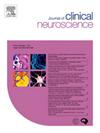Outcomes of single-session gamma knife radiosurgery for deep-seated arteriovenous malformations
IF 1.9
4区 医学
Q3 CLINICAL NEUROLOGY
引用次数: 0
Abstract
Background
Deep-seated arteriovenous malformations (AVMs) pose unique surgical challenges due to their proximity to critical structures. Gamma knife radiosurgery (GKRS) thus serves a promising alternative that may reduce treatment-related morbidity of deep-seated AVMs. However, the efficacy of GKRS in achieving obliteration in deep AVMs is not established. Therefore, we examined our experience with GKRS in deep-seated AVMs.
Methods
We retrospectively reviewed all deep-seated (thalamic, basal ganglia and brainstem AVMs) that underwent GKRS at our center between 2006 and 2022. Factors that predicted obliteration were assessed, and the incidence of various long-term complications was recorded.
Results
The cohort comprised 137 patients, 74 males (54 %) and 63 females (46 %). The mean age was 25.1 ± 11.9 years. The mean dose delivered was 21.7 ± 2.6 Gy. The median volume of AVMs in our cohort was 3.2 cc (IQR: 1.5, 6.3 cc). The median follow-up was 36 months (IQR: 24, 42 months), following which 66 AVMs (48.2 %) were obliterated. Radiation-induced edema occurred in 8 cases (5.8 %), 7 of whom were symptomatic with neurological deficits (5.1 %). However, all patients improved on further follow-up with no residual neurological deficits. The median volume was significantly greater among cases with residual AVM (3.45 cc, IQR: 1.77, 6.85 cc) than those that were obliterated (2.77 cc, IQR: 1.09, 5.10 cc, p = 0.049). The mean Pollock Flickinger score was significantly greater among non-obliterated cases, as was the mean dose delivered (22.3 ± 2.7 Gy vs. 21.5 ± 2.8 Gy, p = 0.044). Multivariate analysis revealed that a nidus volume less than 3 cc was the only factor that predicted obliteration of the nidus (HR: 4.994, 2.139, 9.166, p = 0.016).
Conclusions
GKRS is an effective and safe treatment option for deep-seated AVMs. Obliteration occurred in 48.2% of cases, with complications in 5.8%. Nidus volume, rather than other clinical or radiological factors, appears to be the most significant predictor of successful obliteration. Despite the challenges posed by the complex anatomy of deep AVMs, including variable venous drainage and the potential for radiation-induced edema, GKRS is similarly effective in AVMs located in the thalamus, basal ganglia, and brainstem.
求助全文
约1分钟内获得全文
求助全文
来源期刊

Journal of Clinical Neuroscience
医学-临床神经学
CiteScore
4.50
自引率
0.00%
发文量
402
审稿时长
40 days
期刊介绍:
This International journal, Journal of Clinical Neuroscience, publishes articles on clinical neurosurgery and neurology and the related neurosciences such as neuro-pathology, neuro-radiology, neuro-ophthalmology and neuro-physiology.
The journal has a broad International perspective, and emphasises the advances occurring in Asia, the Pacific Rim region, Europe and North America. The Journal acts as a focus for publication of major clinical and laboratory research, as well as publishing solicited manuscripts on specific subjects from experts, case reports and other information of interest to clinicians working in the clinical neurosciences.
 求助内容:
求助内容: 应助结果提醒方式:
应助结果提醒方式:


